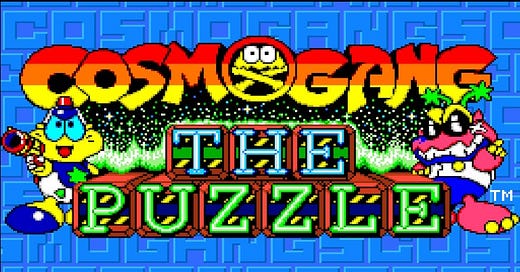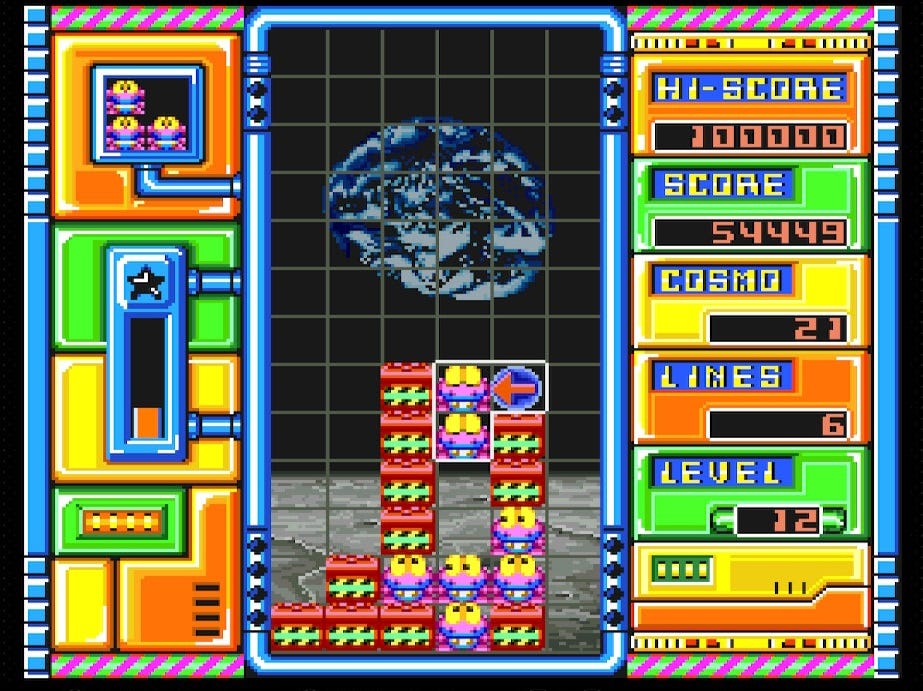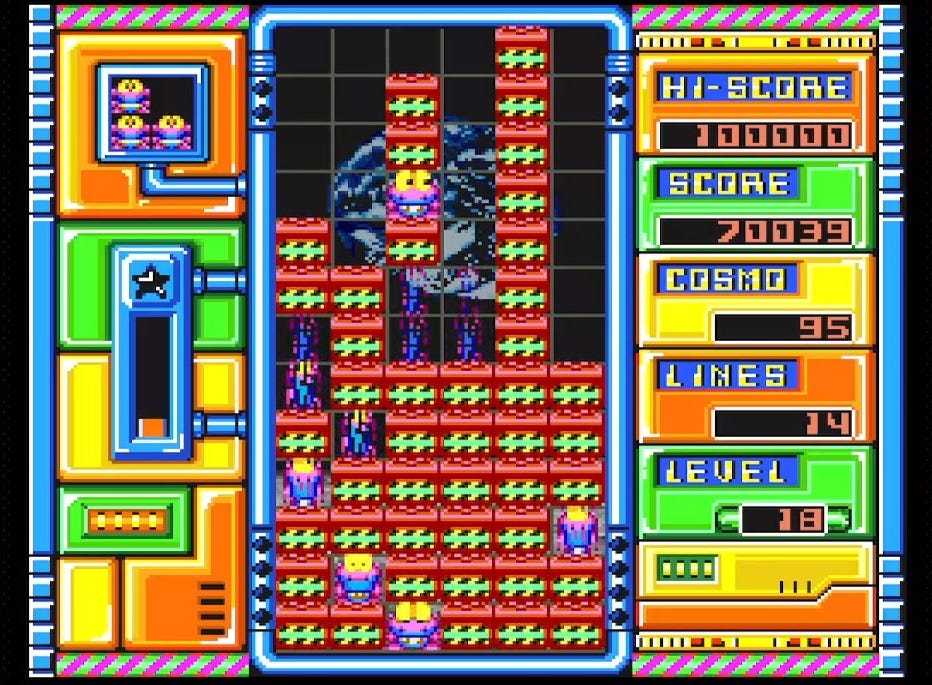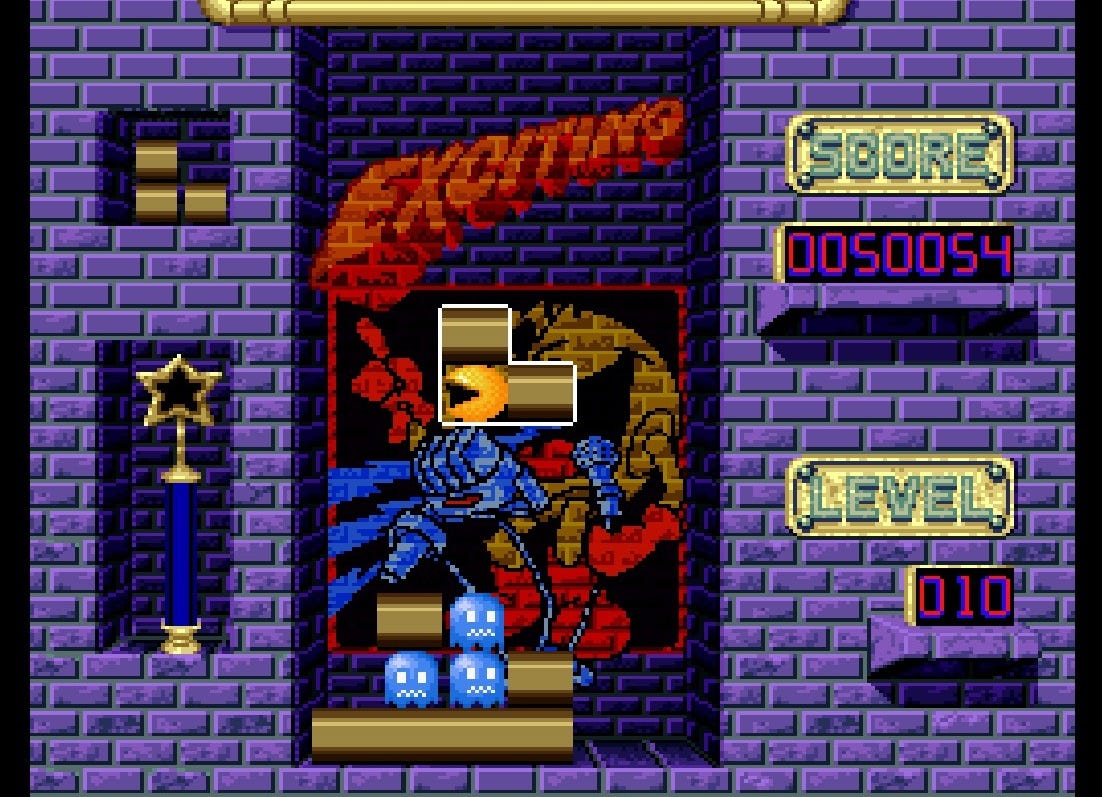Past meets present: Cosmo Gang the Puzzle
You might better know it as Pac-Attack, but this puzzle was originally a spin-off of a different and lesser-known Namco series.
This column is “Past meets present,” the aim of which is to look back at game franchises and games that are in the news and topical again thanks to a sequel, a remaster, a re-release, and so on. Previous entries in this series can be found through this link.
In 1990, Namco released a two-player electromechanical redemption game in Japanese arcades, CosmoGang. Data East then ended up bringing it abroad, where it was slightly renamed as Cosmo Gangs. The point was to fire at approaching aliens — known as Jammers — attempting to steal energy containers, using your light gun. If the Jammers reached your container, it was game over. Simple, and popular.
The last part is confirmed by the fact that Namco didn’t just let CosmoGang be a one-off. Normally you’d think that something like an electromechanical redemption game featuring characters from a video game would be the order of things, playing off of a known quantity in another format like you see even in today’s arcades where licenses abound, but not here: Namco ended up making a pair of video games using characters from the elemecha, instead. Cosmo Gang the Video was the first one — the seemingly odd name makes a lot more sense when you realize it’s telling you the medium you’re playing Cosmo Gang on, yeah? — and it told the story of CosmoGang through a pretty familiar lens. Picture a much cartoonier entry in the Galaxian series, back to the fixed shooter aspects of the earlier titles in that franchise, and you’ve got a pretty good idea of what Cosmo Gang the Video was about.
That video game debut launched in 1992 — March in Japan, April in North America — and was followed up shortly after in the same year by a new take on the CosmoGang formula. This time it was a puzzle game, fittingly and informatively called Cosmo Gang the Puzzle. Truth in advertising was what this series was all about.
While it first launched in arcades, there was also an at-home version of Cosmo Gang the Puzzle for the Super Famicom. Unlike the arcade game, this iteration of the falling-block puzzler didn’t release internationally… sort of. Even if you aren’t familiar with Cosmo Gang the Puzzle, you might actually be familiar with its rebranded, international edition: Pac-Attack. Pac-Attack (or Pac-Panic, depending on your region) launched in North America and Europe in 1993 on the SNES, the same year as Cosmo Gang the Puzzle in Japan, and over the next couple of years also arrived internationally on the Genesis, Game Boy, Game Gear, and Philips CD-i. CosmoGang might have been popular enough as a redemption game to spawn some video game sequels, but Pac-Man is Pac-Man, and using him as a way to wedge into the growing (and crowded) puzzle space made a whole lot of sense.
Cosmo Gang the Puzzle, as an arcade game, wasn’t a rush job, exactly. But it did have a short development cycle that began shortly after the completion of Cosmo Gang the Video, that necessitated asset reuse and a lack of diverse gameplay modes. There are quibbles to be had with the Super Famicom version, but it’s got more on offer thanks to getting a bit more time in the oven, as well as the expectation that a console game would simply have more to do than its arcade counterpart. In addition to the standard endless mode of this kind of puzzle game and the two-player Vs. mode, where you just try to post the highest score you can and outlast your opponent, respectively, there is also a Puzzle mode that sees you completing a series of challenges in a limited number of moves. And that’s where Cosmo Gang the Puzzle shines.
Which is not to say that its more basic modes aren’t worthwhile, because they are. Here’s how Cosmo Gang the Puzzle works: the Jammers are back, now known as Jamms, and they’re a problem to be dealt with through the power of matching blocks. Games like this needed some kind of gameplay change to differentiate them from the competition and avoid being labeled as a Tetris clone, and Cosmo Gang the Puzzle had one. You actually can’t clear the Jamms the traditional way by matching them or creating a row, like you would in a Puyo Puyo or a Tetris or a Columns. Instead, what you’re clearing are the bricks that also fall from the top of the playing area, and the Jamms are there to… well, to jam that process up by getting in the way.
The blocks that fall are three-piece ones that can be shuffled around to be placed in the orientation that works best for you. Pieces hanging off of the edge of a placement will fall to whatever open space is below, be they bricks or Jamms. Six bricks in a row can be cleared, but if a Jamm interrupts — as the one in the bottom row of the above screenshot is — then the row won’t clear. The solution is in that little blue ball with an orange arrow in it, that’s also visible in the screenshot. You use those orbs to clear the Jamms: it will travel in the direction the arrow is pointing, and follow the path you’ve built out of bricks. So, in the case of this screenshot, those two Jamms to the left of the orb are going to fall straight down, now that the ball has been stopped by a brick while pointing left. The orb will then proceed to move left, and bump into a brick, forcing it to fall downward. This will clear the two Jamms it was just connected to, as well as the two below that, freeing space for a brick in the bottom row when the opportunity for that arises, allowing the bottom row the possibility of being cleared.
Most of what’s on display in that screenshot is pretty standard, like the current difficulty Level, Score, and number of cleared lines. On the left-hand side, however, is a partially filled meter with a star at the top of it. When you clear at least three Jamms in one move, the meter slightly fills. When it’s all the way filled, you’ll get a single star piece to drop. You use that to clear a whole bunch of Jamms at once, whether they’re connected or not, and that can cause a chain reaction of cleared lines:
Here in this image you can see what happens after a star is used: a whole bunch of Jamms are in the process of being distorted out of existence. There are four bunched together, plus two on the side, and then another four individual Jams. Each Jamm that disappears is a gap to be filled by whatever was above it, which in this case is a bunch of bricks. A quick glance should show you that the cleared lines tally is about to shoot up from 14, thanks to a combo that’ll also grant thousands of bonus points.
So! Cosmo Gang the Puzzle is not just about fitting pieces where they go, but also about long-term planning. You can’t just haphazardly drop the Jamms, but you have to place them in spaces where you’ll be able to get to them with the balls. You’ll notice quite a few of those Jamms in the star screenshot were stuck keeping bricks from being able to turn into cleared lines, and that’s unfortunate, but it’s also a side-effect of the way the game works. The goal is to minimize the times that happens, and chain together long enough strings of cleared Jamms that you’ll get a number of stars to help you clean up the remnants and unavoidably awkwardly placed Jamms of your past.
Things can get crowded and out of hand in a hurry, since a well-intentioned path you’re building might not work out like you’d hope, or you misplace a piece, and end up cutting off any reasonable hope of clearing what’s below it. As with any puzzle game, however, the more you play, the more you get a sense for how it all works. And playing the Puzzle mode that limits how many orbs you’re going to have access to in the first place while attempting to clear out all of the Jamms will help make you into a better endless player.
As the video shows, it’s about building the proper pathway for the orb to clear as many Jamms as possible in one go. And without leaving behind any Jamms that will be a problem to clear later on, because they’re trapped by bricks or in an awkward space an orb doesn’t have many options for reaching. You get just five of these balls for these puzzles, which increase in complexity as you go, and which means that you need to start to how and where these paths must be made before you even get the pieces to do so. Of course playing this mode will make you a better player in the other modes, since it’s effectively, via trial-by-fire, teaching you how the game actually works at a higher level than just winging it.
Pac-Attack works similarly, both in terms of gameplay and its modes. It’s a reskin with a new soundtrack, and some nifty little Pac-Man-specific touches. For instance, when you’ve got three Ghosts — the obvious replacement for Jamms — lined up (the minimum number for adding to the star meter), they change from their colored form to their susceptible one from Pac-Man, when he’s able to eat them:
And instead of the orbs, you’ve got Pac-Man himself doing the clearing. Otherwise, the bricks now connect to form lines, whereas they’re separate pieces as they come down, and the background, of course, incorporates Pac-Man instead of the space themes of Cosmo Gang.
While Cosmo Gang the Puzzle saw a number of re-releases over the years in Japan, it never made its way outside of it. Until 2024, that is, when the arcade original released as part of Hamster’s Arcade Archives line, and the Super Famicom edition landed on the SNES portion of Nintendo Switch Online. Again, there’s nothing wrong with the arcade version, and it has the benefit of online leaderboards in its Arcade Archives form, but if you’re interested in checking out the title and you have access to a Switch, be sure to give the SFC edition a whirl. That Puzzle mode is Cosmo Gang the Puzzle at its finest, and, as said, is a great way to learn the ins and outs of how to actually thrive at this title.
This newsletter is free for anyone to read, but if you’d like to support my ability to continue writing, you can become a Patreon supporter, or donate to my Ko-fi to fund future game coverage at Retro XP.







